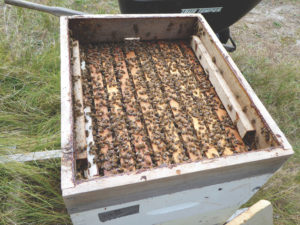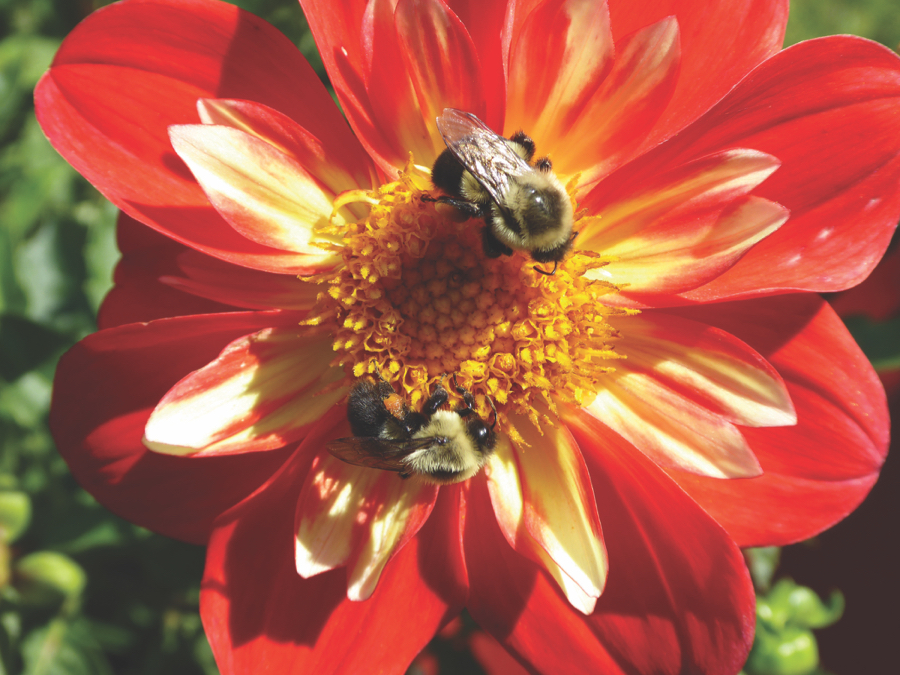 Unlike some bipeds I know, honey bees never seem to procrastinate in their preparations for the big chill of an Outer Cape winter. The bees take advantage of every warm day, coming and going at the hive entrance at a seemingly frantic pace. Like people, they need to ensure a source of heating fuel that will last through the cold flowerless season. For bees, that means collecting, processing, and storing enough honey to eat until the first willows and maples bloom in late March and April.
Unlike some bipeds I know, honey bees never seem to procrastinate in their preparations for the big chill of an Outer Cape winter. The bees take advantage of every warm day, coming and going at the hive entrance at a seemingly frantic pace. Like people, they need to ensure a source of heating fuel that will last through the cold flowerless season. For bees, that means collecting, processing, and storing enough honey to eat until the first willows and maples bloom in late March and April.
The field bees, older workers who boldly venture up to several miles from the hive to collect nectar, carry it back in their honey stomachs and pass it on to younger “house bees” for processing.
Raw nectar will quickly ferment to alcohol and vinegar, reducing or destroying its caloric yield to the bees. But nectar evaporated to 18 percent or less water — that is, honey — is too dry for the growth of fermenting bacteria and fungi. That’s why people have used honey to disinfect wounds, and why it will last in the honeycomb almost indefinitely.
The bees don’t just wait around for the water to evaporate from the nectar. The work of making honey falls to thousands of hive-bound bees, who manipulate the nectar across their mouth parts and fan the comb surface with their wings to dry it.
Honey is the energy source that powers all bee activity. The most important is flight during the warm months, which as you might imagine is a highly energetic exercise. In winter honey takes on another role at least as critical to colony survival: thermal balance of the wintering honey bee cluster.
Most colonies here run through 40 to 50 pounds of honey each winter; those that have stored less fuel than that in the fall often die.

Unlike all other social bees, honey bees survive the winter as an intact colony of thousands of worker bees and one queen; in contrast, all those teeming colonies of other familiar bees (including bumble bees, wasps, and hornets) die out in the fall. Only their newly produced and mated queens overwinter, hiding in a state of cold torpor under bark, shingles, or maybe an abandoned mouse nest.
Honey bees cluster inside the hive in winter, but remain fully metabolically active, consuming honey to fuel the contraction of their wing muscles to generate heat. Think of each bee as a tiny space heater, collectively heating the core of this “superorganism,” the winter cluster, to a quite stable minimal temperature of about 50 degrees F.
Their hives have been winterized to help keep out cold winds. The bees do that with propolis, which they make, starting with tree resins. The Cape Cod pitch pine forests sure seem like a great place to collect that.
The bees make propolis by combining the resins with wax from their bodies, essential oils, pollen, and a bit of bee saliva. Besides being an excellent caulking material to fill cracks and keep out pests, propolis has antiseptic properties. You may have seen it in health food stores; humans have used it medicinally throughout history. It figures prominently in a bee colony’s immune system against parasites like mites and bacterial and fungal pathogens.
Unlike longer-lived animals, individual honey bees around in the fall can’t count on living to become productive members of their community next spring. For the colony to survive the winter and prosper it must produce fat “winter bees” in the fall.
That’s where pollen comes in as part of the colony’s preparations for winter. Fat winter bees will have the protein reserves to jump-start the colony the next year. To produce winter bees, there is a surge in egg-laying by the queen, followed by copious feeding of the resulting bee larvae with protein-rich field-collected pollen from late August through September.
Watch the entrance to a beehive on a warm mid-October morning and you will see workers still returning to the hives with legs laden with bright yellow goldenrod pollen. You know this means that inside the hive the winter bees are emerging to fulfill their role as the colony’s bridge to spring.



